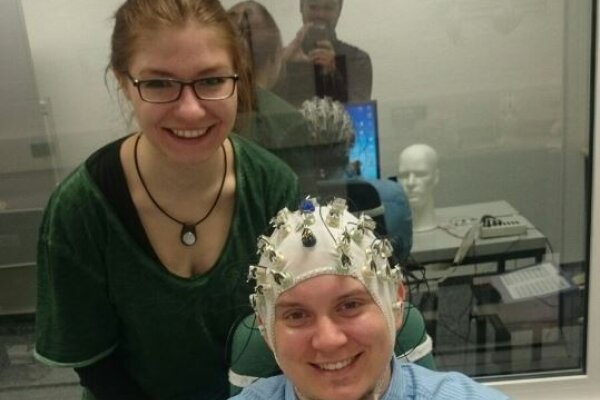2017-05-12

While the two halves of the human brain are connected via white matter commissures, it is difficult to estimate the speed with which the hemispheres share their information.
For a long time, it was believed that a simple behavioral task would do the trick: In one condition, a stimulus is presented on one side while participants should react with the hand of the same side. In the other condition, the stimulus and reacting hand are on different sides. Hence, in the first condition both perception and reaction occur in the same hemisphere, while in the second condition, perception and reaction are processed in different hemispheres. Therefore, the difference in reaction time between the two conditions should reflect the transfer time between the two hemispheres, right? Well, kind of but not quite. For instance, this paradigm is not reliable - If you measure a person today and a week later, the results may vary!
Here, we tested an alternative approach. Instead of relying on reaction times, we calculated the difference in event-related potentials, using the same paradigm with an EEG system. Our results show that with this approach, transfer times measured today are comparable to transfer times measured one year later! Hence, this method allows us to get reliable estimates for the speed of interhemispheric information transfer.

While the two halves of the human brain are connected via white matter commissures, it is difficult to estimate the speed with which the hemispheres share their information.
For a long time, it was believed that a simple behavioral task would do the trick: In one condition, a stimulus is presented on one side while participants should react with the hand of the same side. In the other condition, the stimulus and reacting hand are on different sides. Hence, in the first condition both perception and reaction occur in the same hemisphere, while in the second condition, perception and reaction are processed in different hemispheres. Therefore, the difference in reaction time between the two conditions should reflect the transfer time between the two hemispheres, right? Well, kind of but not quite. For instance, this paradigm is not reliable - If you measure a person today and a week later, the results may vary!
Here, we tested an alternative approach. Instead of relying on reaction times, we calculated the difference in event-related potentials, using the same paradigm with an EEG system. Our results show that with this approach, transfer times measured today are comparable to transfer times measured one year later! Hence, this method allows us to get reliable estimates for the speed of interhemispheric information transfer.